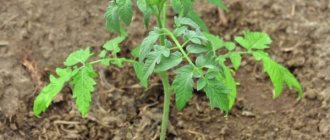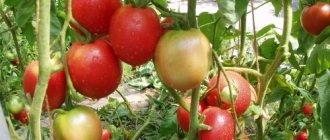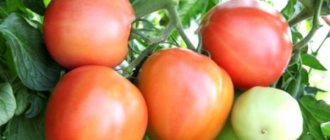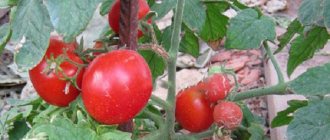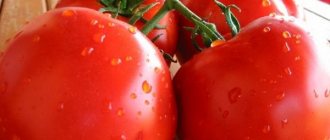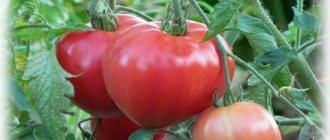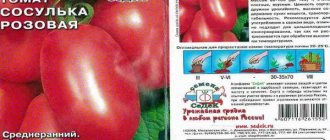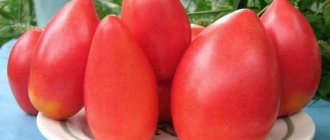Tomato Raspberry Paradise F1 is a representative of the subspecies of tomatoes with sugar raspberry pulp, which are recognized as the most delicious and sweet. The tomatoes are spectacular in appearance, fleshy and bright. An ideal variety for juices and salads.
| Height | Landing location | Ripening time | Fruit color | Fruit size | Origin | Fruit shape |
| Tall | Greenhouse, Open ground | Early ripening | Pink | Large | Hybrid | Flat-round |
Diseases and pests
The current variety has its own distinctive properties - it is resistant to most diseases that affect the ass. This is determined by the fact that the plant is almost not exposed to the most basic diseases: tobacco mosaic, fusarium. Of course, some people rely on their own experience. They advise carrying out preliminary work to prevent plant infection. Tomatoes are treated with a small solution of potassium permanganate or with special means. It is also recommended to disinfect the soil using copper sulfate, one or the other is dissolved in water. The work is carried out before planting tomatoes. Products that contain a blister are perfect for preventing infection and the spread of diseases.
In addition to various diseases, the Raspberry Paradise brand can be damaged by insects. To combat pests, plants are sprayed with special chemicals made at home.
Raspberry Paradise is quite whimsical, but summer residents choose nothing other than this variety of tomatoes. After all, it has a rich harvest, exemplary and juicy taste.
Growing tomatoes
In most cases, the Raspberry Sunset F1 tomato is grown through seedlings.
Sowing seed material
How to sow seeds for seedlings:
- Sowing of planting material in specially prepared containers begins in early March;
- The soil for future seedlings is prepared in advance, in the fall. Mix humus, river sand and garden soil in equal proportions. Thanks to this soil composition, you can get an excellent harvest;
- Before sowing, the soil must be disinfected using a weak manganese solution. This treatment helps to destroy all pathogens that may be in the soil;
REFERENCE: Mandatory pre-sowing treatment of seed material is carried out with effective preparations “Baikal EM1” or “Ecosil”. The drugs are growth stimulants that simultaneously have a fungicidal effect, disinfecting the seed material.
- Each container is filled with prepared and treated soil mixture, into which about 20 seeds are sown, deepened by 1.5-2 cm;
- After a small number of seedlings appear, they need to be thinned out a little, leaving only strong and healthy ones;
- Water the seedlings once every 7-10 days;
- As soon as two true leaves are formed, they begin picking into separate pots. It is advisable to give preference to peat containers to avoid injury to the root system when planting seedlings in a permanent place;
- Two weeks before the planned planting, seedlings begin to harden off. To do this, they are left in the open air at first for half an hour, and then gradually increasing the period of their stay on the street.
Rules for planting seedlings
Instructions for proper planting:
- Since the hybrid is quite thermophilic, it is better to avoid shaded areas. It is advisable to choose an area with good lighting throughout the day;
- Planting in a permanent place begins after stable warm weather has established, as soon as the threat of return frosts has passed;
- Recommended planting pattern is 70x30-40 cm.
Growing instructions
For planting Raspberry Paradise tomatoes, the seedling technique is best used. Before sowing, materials are prepared.
Step-by-step outline of the work:
- The seeds are soaked in a special solution for growth.
- Ground forward. Ant. then prepared from black soil with the addition of humus.
- Plants are planted approximately in the middle of the Lady in open ground.
- Seeds are planted in special tanks so that the sources are not damaged.
- For rapid germination of seeds, moderate air supply is required, at a temperature of about 24 degrees.
They care for the plant and plant them exactly according to the following rules:
- Containers with plants are placed in the light and moderately sprayed with water from a spray bottle.
- After 49 days from the day when the first seed appeared, the tomatoes must undergo hardening. They are taken out to a cool place or outside for about 2 hours.
- After the soil has warmed up well, the tomatoes are planted. Plants are planted outside in early June. In mid-May they are planted in a greenhouse structure.
- Replant in high-calorie soil, making small holes.
- If the tank is made of peat, then the seedlings are placed in holes, covered with earth, and watered with warm water.
- It is recommended to fertilize the soil before placing the seedlings in the ground. In order for the plant to bear a lot of fruit, you need to take care of your tomatoes seriously.
- When the plant grows to a certain size, it needs to be tied to wooden supports.
- If the tomatoes are not tied up, the fruit clusters may break off due to their weight.
- Excess shoots are removed so that the plant has a Vodan stem.
- Throughout the season, the soil is fertilized approximately 3 times, and liquid fertilizers are used.
If you follow all the recommendations and instructions, then tomatoes can be protected from various diseases and damage. This will also allow you to grow a good harvest. They also take into account that if you do not fertilize the soil, the crops may produce less yield and smaller fruits.
Sowing seeds for seedlings
To grow seedlings, you need high-quality seeds from a trusted supplier.
Did you know? Hybrid
"
f1
"
cannot be grown from self-collected seeds. To get a tomato with the appropriate characteristics, you need to buy seed again from the manufacturer.
Optimal timing
Seedlings are prepared 60–65 days before transplanting into a greenhouse or open bed. The exact sowing time depends on the region and the ability to use additional lighting. The average date is mid-March.
Soil mixture
A large selection of soil mixtures for growing seedlings is available in shopping and garden centers. If you decide to prepare the soil yourself, it is necessary to carry out preliminary disinfection of the soil collected in the garden or other place.
There are several ways to destroy possible sources of diseases and pests:
- pour in a solution of potassium permanganate;
- expose to water vapor for 7–8 minutes followed by cooling;
- leave for 30 minutes in the oven at +70°C–+90°C;
- freeze and let thaw (repeat the procedure 2-3 times). The temperature in the cold should be –15°C––20°C, and the ground should thaw within 3–5 days.
We recommend reading about such tomato varieties as “Oxheart” and “Sugar Bison”. Fertilizers are added to the bucket of the resulting mixture:
- a teaspoon of urea;
- a tablespoon of potassium sulfate;
- three tablespoons of superphosphate.
Growing container
The optimal container for seedlings is ready-made plastic or peat containers with a transparent lid that will not touch the ground. Such a shelter will provide a greenhouse microclimate favorable for seed germination. If there is no lid, you can use glass or film.
Seed preparation
The first rejection consists of inspecting the seed and removing damaged seeds. Further:
- soak in a weak solution of potassium permanganate. Seeds that have sunk to the bottom are tested for germination;
- Soak selected seeds in “Epin-extra”, “Zircon” or “Kornevin”, which are modern growth stimulants.
Find out also about the features of using copper wire against late blight.
Sowing seeds
Sowing is carried out according to the standard scheme to a depth of 1–1.5 cm. The first watering with warm water is done from a spray bottle to avoid washing out the seed with a stream of water. Then you need to close the container with a lid and put it in a warm place.
The tomato germinates in 7-10 days. Until this point, the lid is opened only to spray dried soil. If condensation appears on the walls, it must be removed.
Seedling care
Sprouted tomatoes are placed in a well-lit place at a temperature of +15°C–+16°C, and then it is raised again to room temperature.
For healthy seedlings it is necessary to provide:
- careful watering by spraying warm water under the roots;
- no waterlogging;
- good lighting.
Did you know? It is believed that replanting with cutting off the main root by one third stimulates the growth of the lateral root system. This method provides the future plant with better nutrition.
Fertilizing of seedlings is carried out in case of obvious lack of nutrients, which can be judged by the appearance of the plants:
- lack of potassium is manifested by leaf wrinkling;
- lack of phosphorus is visible by purple veins on the stems and lower parts of the leaves;
- yellowing and falling of the lower leaves is a signal of nitrogen deficiency.
Hardening of seedlings
To prevent the seedlings from being subjected to too much stress in their permanent location, they begin to prepare them for new conditions in advance. The hardening process begins 7–10 days before transplantation.
The plants are taken out into the open air, first for half an hour, and then the time is increased to full daylight. It is necessary to monitor the temperature: the minimum mark for tomatoes is +8°C. The place chosen for the procedure should not be in a draft and should not be illuminated by direct rays of the sun. For hardening at home, you can use a balcony with open windows.
Recommendations for tomato agricultural technology
When purchasing seeds, you need to study the information very carefully and choose the Raspberry Giant variety and not a hybrid.
Sowing seeds
The usual time for sowing seedlings of such tomato varieties is March; more precise dates are determined taking into account the climatic conditions of the region and the phases of the lunar calendar. Before sowing prepare:
- soil for seedlings;
- pots, boxes, cups - containers where tomatoes will grow first, and then after diving.
The seed material is calibrated, then soaked in a roughly pink solution of potassium permanganate. Many people know about this simple example of seed disinfection, but they often violate the holding time or concentration of the composition. Tomato seeds are soaked for no more than 15-20 minutes, the concentration of the solution should be minimal.
After a “bath” in potassium permanganate, it is recommended to rinse the seeds with clean water. The next stage is soaking in a growth stimulator, for which they use EPIN, aloe juice diluted in water or a saturated ash infusion. Then the seeds are placed in damp gauze for germination (you can use cotton pads or napkins).
As soon as the sprouts appear, the seeds are sown in boxes with soil, covered with film and put in a warm place. From the moment the first shoots appear, the coverings are removed and the tomatoes are exposed to light.
Caring for seedlings
When germinating seeds, the temperature should be within +25°C...+27°C. As soon as the shoots appear, the temperatures are reduced to +18°C and this regime is maintained for about 4-5 days.
Subsequently, the temperature should be +20°C...+23°C; tomatoes do not like extreme heat. With insufficient lighting, abundant watering and high temperatures, the plants will stretch, but this should not be allowed.
Therefore, they maintain optimal air temperatures and water regularly, but moderately. In March and April, lamps are used to illuminate plants.
As soon as the seedlings have 2-3 leaves, the tomatoes are picked. The procedure allows you to slow down the stretching of seedlings, build up a strong root system for tomatoes, and cull the weakest seedlings.
Water the tomatoes with warm, settled water, making sure that drops of water do not fall on the plants. The soil should be slightly moist, but without excess moisture. Tomatoes in hot rooms with abundant watering are susceptible to blackleg disease, and it is necessary to prevent this phenomenon. As a preventive measure, you can use water with potassium permanganate (a faint pink solution) for irrigation, carefully ventilate the premises, and avoid temperature changes.
After diving, the seedlings are fed twice (with an interval of 10-12 days), for which complex fertilizers are used. Also suitable for tomatoes are such compositions as Kemira, Ideal, Agricola.
It is very important that the seedlings, when planted in a permanent place, are strong and hardened. In about 10-14 days, tomatoes begin to gradually adapt to new conditions, for which they are taken out to balconies, loggias, or into a greenhouse
You can open windows and vents, but only if weather conditions permit.
The plants are first kept for about 15-30 minutes, and then the time is increased to several hours.
Planting
The timing of tomato transplantation is determined depending on the region, taking into account the air temperature, plant growing conditions (in beds, in shelter).
In unprotected soil, the Raspberry giant is grown even in regions such as the Urals and Siberia, and provided there is a good summer, the harvests will be excellent. But it is still advisable to think over options with a greenhouse in such areas, then the result will be guaranteed.
Plants can be planted in shelters from the end of April (middle zone), in mid-May (more northern regions). In open ground - at the end of May or beginning of June. The soil should warm up to +14°C...+16°C, for which you can cover the ground with black film about 7-10 days before planting.
This variety is planted three bushes per square meter, in pre-prepared holes. Small plants of this tomato do not need powerful supports, but stakes can be placed in open ground.
Description of the variety
The “Golden Raspberry Miracle” series of tomatoes consists of several hybrids, each of which has its own distinctive characteristics. The “Golden Raspberry Miracle” variety includes the following varieties of tomatoes:
- “Crimson Sunset” - the hybrid is characterized by good yield and large fruits weighing from 500 to 700 grams;
- “Raspberry Wine” tomatoes are the most aromatic and tasty fruits of the review series, weighing 300-400 grams;
- The “Bright Robin” fruits taste like watermelon and weigh 400-700 grams;
- Hybrid tomatoes "Raspberry Paradise" weigh 500-600 grams, have a very sweet taste and juicy pulp;
- “Berry-raspberry” – bright, small tomatoes weighing 300-500 grams.
REFERENCE: All varieties of “Golden Raspberry Miracle” tomatoes are first generation hybrids.
Indeterminate plants reach a height of two meters. Tomatoes grow and bear fruit to the last bunch.
The “Golden Raspberry Miracle” varieties are mid-late varieties - 150 days pass from the appearance of sprouts to harvest.
Tomatoes can be grown both in greenhouses and in unprotected soil.
Description of “Golden Raspberry Miracle” tomatoes:
- Large fruits weighing from 300 to 700 grams;
- Crumbly, juicy pulp;
- Sweet taste;
- Amazing aroma;
- Versatility in use;
- Dense smooth skin;
- Ribbed surface;
- Amount of dry matter – 6%;
- A few seed chambers and seeds.
IMPORTANT: In order for tomatoes to spoil less, they need to be laid with the stalk facing up.
Tomatoes can be stored fresh for a long time. To increase shelf life, fruits must be placed in wooden boxes or plastic containers. Tomatoes should be stored in a cool, dark place so that they do not touch each other.
Series related to the Raspberry Miracle variety
The first series of Raspberry Miracle tomatoes includes the following tomato varieties:
- Crimson sunset. This variety belongs to the early ripening crop. Reaches two meters in height. The fruits of the Raspberry Sunset variety are round and reach 350 grams. From each square meter you can harvest 12 kilograms of tomatoes.
- Raspberry wine. The plant reaches a meter in height, the fruits of the variety are small, not more than three hundred grams. The fruits should be eaten fresh.
- Bright robin. An early ripening variety, reaches a meter in height, has round fruits, weighing up to 400 grams. From each square meter you can get 12 kilograms of fruit. Tomatoes have a pleasant taste and are used for fresh consumption.
- Raspberries. An early ripening plant, reaches up to half a meter in height. Sings by mid-July. The round fruits, up to 400 grams, are consumed fresh. From each square meter you can collect up to 13 kilograms of fruit.
- Raspberry paradise. Early ripening variety. The fruits grow up to 500 grams, the plant reaches a meter in height. Up to 12 kg of tomatoes are collected from each square meter and consumed fresh.
In the first series, tomatoes are unpretentious, grow well in various regions of the country, bear fruit well and are disease-resistant.
The second series included such hybrids as:
- Raspberry joy. An early ripening variety, the fruits ripen in June. The tomatoes are small, only 150 grams each. The plant reaches a meter in height, and for every square meter it will produce a harvest of 14 kg. The skin of the tomato is dense; the tomato is suitable for both fresh consumption and canning.
- Raspberry bison. The fruits ripen by mid-July, the fruits weigh 350 grams, the plant reaches a meter in height. From each square meter you can collect up to 12 kg. fruits The pulp of the variety is dense, the skin is smooth.
- Raspberry King. Mid-season variety, tomatoes weighing up to 350g. The bush reaches a meter in height. The fruits are flat-round and are eaten fresh. From each square meter you can collect up to 10 kg. fruits
- Raspberry dream. An early-ripening variety, the tomatoes have a flattened shape, weighing up to 350g. The tomato variety Raspberry Dream reaches a meter in height. From each square meter you can remove 14 kg. fruits for the whole season.
- Raspberry desirable. The tomatoes will ripen by mid-summer, the weight of the fruit is 300 - 400 grams, the plant reaches a meter in height. From each square meter you can collect up to 13 kg of fruit per season. This variety of tomatoes has a ribbed surface and is consumed fresh.
In the second case, breeders focused on the shape and taste of the fruit. The third series includes the following hybrids:
- Raspberry popsicle: The hybrid bush is low, only 90 cm. The fruits have a slightly ribbed surface and weigh up to 300g. From each square meter you can collect 14 kg of fruit per season.
- Raspberry heart. The plant is not tall, the shape of the fruit is heart-shaped, which is why they have this name. Fruit weight up to 300g. From each square meter you can harvest up to 13 kg of tomatoes.
- Raspberry bunny. Frost-resistant variety. Reaches a meter in height. Fruits weighing 350g are best used fresh. From each square meter you can harvest 12 kg of tomatoes.
- Raspberry surprise. The plant reaches 90cm. in height, the fruits have a flat-round shape, weighing up to 350g. From each square meter you can collect 14 kg of fruit per season.
- Raspberry hero. They have a distinctive feature over all hybrids in this series. The Raspberry Bogatyr variety has large fruits, weighing up to 500g, the fruits have a strong skin and do not crack. The plant reaches a meter in height; 15 kg of fruit can be collected from each square meter.
The advantages of this variety Raspberry Miracle differs from other varieties in that it is unpretentious in care and cultivation, as well as in the fact that the fruits do not crack during long-term transportation.
"Bright Robin"
This is a raspberry-fruited tomato, like the rest of the originator of LLC NPO "Garden and Vegetable Garden" variety and the designation "Yarkaya Malinovka" F1 is, of course, inappropriate. The variety was entered into the register in 2015 under number 8557423
Characteristics and description
If we consider the characteristics of this variety, the one submitted by the registration center, it is impossible to find differences from the “Raspberry Wine” variety, with the exception of the registration number itself.
The description and characteristics of the two varieties are absolutely identical. Since the varieties are still very young and few vegetable growers have been able to grow both varieties and understand the differences, we can only hope that time will show which variety will remain and which will be forgotten.
The raspberry miracle tomato series has good reviews. Those vegetable growers who started growing varieties are very satisfied, first of all:
- early maturation;
- taste;
- productivity;
- large-fruited;
- resistance to diseases.
Judging by the fact that the varieties quickly entered the register and are intended for cultivation throughout the Russian Federation, including the southernmost and northernmost regions, the varieties of this series have special plasticity and the ability to adapt to environmental conditions.
In 2021, the series was replenished with new products that are not distinguished by early ripening, but are likely to win the hearts of vegetable growers:
- “Raspberry Heart” - heart-shaped;
- “Raspberry popsicle” - round;
- “Crimson Bogatyr” - flat-round;
- "Crimson Bison" - round;
- “Crimson Desirable” is flat-round.
If all these tomatoes produce round fruits, then the created “Raspberry King” also has ribbing.
No matter what genetic potential is invested in the variety, without proper care, it is impossible to grow a large-fruited, sweet and tasty tomato on poor soils. Tomatoes from the “Raspberry Miracle” series will be high-yielding and tasty if vegetable growers provide them with the best soil and provide them with constant watering, fertilizing and formation.
Tomatoes Golden Raspberry Miracle: variety description
The “Raspberry Miracle” variety turned out to be so successful that breeders actively began breeding hybrids that compensated for the slightest shortcomings of the others. Each hybrid from this series has its own properties and improves the qualities of the previous ones.
Vegetable growers often purchase several hybrid varieties of these tomatoes at once:
- "Crimson Sunset" has a very high yield and large fruits. The peel is smooth, rich raspberry color. The fruits weigh 500–700 grams.
- "Raspberry Wine" This hybrid is small, with an incredibly bright taste. The most fragrant of all varieties in this series. Fruit weight is 300–400 grams.
- “Bright Malinovka” is a unique hybrid; the taste of tomatoes is very reminiscent of watermelon, as is their consistency. All tomatoes 400–700 grams.
- "Raspberry Paradise" - medium-sized and very sweet fruits. Weight 500–600 grams.
- “Berry-raspberries” are medium-sized, juicy fruits with a bright color. Fruit weight 300–500g.
You can compare the weight of fruits with other varieties in the table below:
| Variety name | Fetal weight |
| The president | 250-300 grams |
| Bella Rosa | 180-220 |
| Gulliver | 200-800 |
| Pink Lady | 230-280 |
| Andromeda | 70-300 |
| Broody | 90-150 |
| Brawler | 100-180 |
| Grapefruit | 600 |
| De Barao | 70-90 |
| De Barao the Giant | 350 |
All hybrids are designated F1, which means a first generation hybrid. All tomatoes from the “Golden Raspberry Miracle” series are hybrid. The best breeders have worked on them for many years to achieve just such taste and external characteristics. The varieties were bred in Russia at the end of the twentieth century.
Tomatoes are classified as indeterminate. They grow until the last knot is tied, and if the climate is suitable, then growth continues for several years. This particular variety can reach two meters in height, it definitely needs to be tied up, the bush is not a standard one.
The varieties of the “Golden Raspberry Miracle” series are mostly medium-late, requiring approximately one hundred and fifty days from the appearance of the first shoots to the ripening of the fruits.
In the course of improvements to this variety, it began to provide amazing resistance to late blight, so you will never see darkened shoots or black spots on the fruits on the bushes. Tomatoes can be grown both in a greenhouse and in open ground; they are very unpretentious.
Summer residents about the Crimson sunset
Selling companies stubbornly offer “Crimson Sunset” F1. But this is not a hybrid, but a variety.
The tomato was brought to the market by the originator - LLC NPO "Garden and Vegetable Garden" Chelyabinsk region. Russia. The variety was entered into the register under number 8557426 in 2015 and recommended for cultivation in all regions of the Russian Federation
The variety, like the previous one, is early ripening and determinate.
The fruit is flat-rounded with an average weight of 300 to 340 g. The skin is smooth crimson, without a spot at the stalk. Medium density.
When cut, 6 nests are visible. The tomato pulp is fleshy, raspberry-colored, and homogeneous.
The variety was rated “excellent” for its taste. Salad tomato.
The Raspberry Sunset tomato has a number of advantages:
- early ripening;
- excellent taste;
- large fruit;
- high yield (up to 12 kgm2).
This variety is moderately affected by diseases and pests. Preventive treatments will maintain high yields.
“Crimson Sunset” is a determinate variety. Large fruits are heavy and require fixation.
Attachment to support systems is a mandatory event.
In addition to those described above with round and flat-round fruits, in the same year they introduced a number of tomatoes into the register, which differ only in the shape of the fruit:
- “Raspberry Dream” - flat-round;
- “Raspberry Joy” is ovoid.
All these varieties are early and large-fruited.
Each tomato in this series is of interest, they are all F1 hybrids (first reproduction):
- Raspberries;
- Raspberry Paradise;
- Bright Robin;
- Raspberry wine.
The names alone are worth it, let alone the characteristics of the fruits of these hybrids. Their description is worth a lot. Each hybrid from the Raspberry Miracle series has fruits weighing from 400 g and above. The best specimens of Crimson Sunset reach 700 g, while other hybrids have a declared weight of slightly less - 600 g.
Description
Let's start the description of the variety with the characteristics of the bush. Crimson sunset F1 - powerful, tall plants of determinate type. According to reviews from amateurs, in a greenhouse the bushes grow up to 2 meters. The leaves are medium in size and dark green in color. Fruit ripening occurs in the early stages (from 90 to 110 days from germination).
Vegetables can be grown under temporary film-type shelters and in greenhouses. The fruits are round in shape, large in size, covered with a smooth, durable raspberry skin in ripe tomatoes; in unripe fruits they are light green in color.
There is no dark green spot in the stalk area. The pulp is of medium density and contains up to 6% dry matter. The number of nests is six. The average weight of the fruit is from 400 g. The taste of the fruit is excellent. The yield in the greenhouse is 13 kg/m².
It’s always interesting to read reviews from summer residents about the past season. It is always interesting to buy a variety that has been tested by others. With the help of good care, I want to achieve better results than others. Reviews provide new information about the characteristics of a particular variety and motivate tomato lovers to new “garden” exploits.
Galina
I want to share my impressions of growing Raspberry Sunset tomatoes. At first I was attracted by the name of the series of seeds - Raspberry Miracle from. I chose Crimson Sunset and did not regret it. The tomatoes are really wonderful, all my neighbors went to admire them.
Red, large, beautiful fruits were pleasing to the eye. The hot, dry summer did not affect the yield. The bushes reached right up to the ceiling of the greenhouse. The weight of the fruit ranged from 300 to 600 g. I fed it once every two weeks, watered it weekly, sometimes twice a week. The tomatoes did not ripen well, they ripened right on the bushes, some were removed and ripened in boxes.
Antonina
I succumbed to the advertising and bought a bag of Raspberry Sunset. She looked after the tomatoes diligently, fed them with fertilizers, and shaped them into one stem. The bushes turned out to be strong and neat; the largest tomato weighed about a kilogram. I liked the variety and will plant it.
Diseases and pests
The most likely disease of this variety is tomato blossom end rot. They fight against it by reducing the nitrogen content in the soil while adding calcium. Also effective measures would be to increase soil moisture and spray the affected plants with a solution of calcium nitrate.
The second most common disease is brown spot. To prevent and treat it, it is necessary to reduce watering and adjust the temperature, regularly ventilating the greenhouse. Of the pests, this type of tomato is susceptible to the Colorado potato beetle, which causes enormous harm to the plant.
Pests are collected by hand, after which the plants are treated with Prestige. Slugs are fought by loosening the soil and sprinkling with pepper and ground mustard, approximately 1 teaspoon per square meter. m.
As you can see, there are certain difficulties in caring for the Raspberry Wine variety, but they are quite surmountable; it is enough to follow simple rules of care. Good luck to you and have a good harvest.
You can watch gardeners’ impressions of the Raspberry Wine tomato variety in the video below:
| Mid-early | Super early | Mid-season |
| Ivanovich | Moscow stars | Pink Elephant |
| Timofey | Debut | Raspberry Onslaught |
| Black truffle | Leopold | Orange |
| Rosaliza | President 2 | Bull forehead |
| Sugar giant | Pickling miracle | Strawberry dessert |
| Orange giant | Pink Impression | Snow fairy tale |
| Stopudov | Alpha | Yellow ball |
Growing conditions
Growing seedlings must be approached responsibly and provided with certain conditions. The room where the containers will be located must be warm - at least +22°C. Air humidity is not the main indicator; the main thing is to ensure that the soil on the surface does not dry out. When the seeds have not yet hatched, they do not need light; on the contrary, the boxes are kept in a warm and dark place.
But already growing tomatoes need light, and they will also need artificial additional lighting in the evenings. As for the soil, there is a choice - buy ready-made in the store, specifically for seedlings, or prepare it yourself. To do this, just mix equal parts of turf soil, sand and peat. The soil should be non-acidic, loose and light. It is first disinfected - either with boiling water, or a solution of potassium permanganate, or by heating it in the oven at +50°C.
Description and rules for growing tomato Raspberry Paradise
The most popular and unique variety of tomatoes is considered to be the Raspberry Paradise tomato. This species has an unusual sweetish taste and bright crimson color.
The Raspberry Paradise variety has received many awards at agricultural exhibitions and is a favorite among professional vegetable growers and large-scale tomato production. The description of the variety allows novice gardeners to become familiar with all the subtleties and features of caring for and growing crops.
General characteristics of the variety
The variety Raspberry Paradise is a hybrid and belongs to the indeterminate species. It is grown both in open ground and in greenhouses and greenhouses. In greenhouse conditions, the bush grows large and spreading, sometimes it can reach 2 m in height. In open ground, the plant has a more compact appearance and on average its height does not exceed 1-1.5 m.
An adult plant has a strong and massive stem. The foliage on it is moderate, normal in shape, and its color is dark green. Experienced vegetable growers recommend placing a support and tying up the bushes, since when the fruits ripen there is a large load on the stems.
The tomatoes ripen evenly and uniformly, with 3 to 5 tomatoes on each bunch. They are crimson in color with a pink tint. Tomatoes grow quite large and round in shape. One fruit can weigh 500-650 g.
At the base of the tomato, ribbed grooves are clearly visible around the stalk. The description of the fruit has its own peculiarity: the Raspberry Paradise tomato has a matte peel of medium density. Experts note that basically all types of vegetable crops have a shiny surface, unlike the Raspberry Paradise variety. This peel protects the fruit well from cracking, so the harvest can be stored in a cool and well-ventilated area for up to 3-4 weeks.
The Raspberry Paradise variety tolerates long-distance transportation well. Green fruits can ripen perfectly in a room at room temperature, but in this case a slight sour taste may appear.
The description of the taste of this type of tomato suggests that the fruit contains a higher level of sugar than other varieties. It is this feature that gives them a unique soft honey taste and aroma with a fruity tint. This variety is very popular among children and connoisseurs of original salads with a sweetish taste. The fruits of Raspberry Paradise have juicy, tender pulp that seems to melt in your mouth.
A brief description and description of the variety gives a complete picture of the culture:
- grown in open ground or under film;
- representative of the early ripening group;
- refers to sweet varieties;
- universal use of the crop: suitable for making pasta, lecho, juice, dressing and pickling;
- has good productivity;
- resistant to many diseases.
The description of the variety indicates that it is sensitive to temperature changes and not resistant to frost. For good growth and abundant harvest, the plant needs well-fertilized soil.
Growing rules
Despite the fact that Raspberry Paradise was bred by Siberian breeders both for planting in open ground and for growing in greenhouses, the description of the variety recommends that gardeners in the northern regions grow this type of tomato under a film, as it is afraid of frost.
On the seed packaging you can find a complete description of the species and rules for caring for it. Tomatoes are grown in seedlings, so before planting, the seeds must be prepared as follows:
- Soak in a growth stimulator to further activate the planting material.
- Soak the seeds in a weak solution of manganese. This will help to avoid diseases and pests in the future.
You can create the soil for sowing yourself. To do this, you need to mix the soil with peat, humus and river sand. Plant the seeds in a special container. Planting takes place at the end of March.
The box with seedlings is placed in a well-lit place without drafts. Water the young sprouts with settled warm water from a spray bottle. As soon as a couple of strong leaves appear on the sprouts, you can plant them in peat pots.
At the age of 50 days, the seedlings are hardened off by taking them outside for 1-2 hours. They are planted in peat pots, sprinkled well with soil and mulched. Further care of the plant consists of regular watering, fertilizing and loosening the soil.
The description of the variety shows that the planting material is ready for planting in open ground in the first half of June. They can be planted in the greenhouse at the end of May.
Raspberry Paradise tomatoes have the most positive reviews from both amateur gardeners and professionals. The variety has excellent taste, gives a good harvest and does not cause difficulties during cultivation.
Variety Raspberry Paradise and its characteristics
This variety is early ripening. Its distinctive properties are excellent gravity and good yield. The main characteristics of this variety:
- It is indeterminate - in a greenhouse, the elevation of the plant can be up to 2 meters.
- The leaves have a dark faded green color.
- One small cluster can have from 2 to 4 fruits.
- The butt is large - about 550 grams.
- Vegetables have ribs, which are located shoulder to shoulder of the stalk, the fruits have a rounded shape.
- The skin of tomatoes looks matte and thin, has a dimensionality that protects tomatoes from cracking.
- Ripe fruits have red, sugary and juicy mesophyll.
- This variety is distinguished by its sweet taste.
Thanks to its delicious qualities, this type of tomato is loved by children. Summer residents use vegetables in seasoning soups, make tomato sauces and juices.
The Raspberry Paradise variety has positive qualities:
- Due to the fact that tomatoes are well preserved, it is possible to transport them over long distances.
- Green tomatoes ripen quite quickly at home.
- Planted tomato bushes are resistant to diseases.
- If you take proper care of the plant, it will give a good harvest.
This variety also has some disadvantages. These include:
- plant phobia to frost;
- Requires good and nutritious soil.
Important!
Even if the climate is cool, it is recommended to plant tomatoes in greenhouses.
Features of cultivation
Among the main features of this hybrid are its record yield, wonderful taste and appearance, resistance to the most common types of diseases, and relative ease of cultivation. Ripe tomatoes can be stored for a long time and tolerate transportation well.
Seeds for seedlings are sown in March-April. Before planting seedlings, they are hardened off for 5-6 days.
The only difficulty that arises when growing is the increased demands on watering and lighting regimes.
Due to the large size of the plant, its branches need garter. The plant loves the sun very much, but does not tolerate extreme heat and stuffiness.
In the stage of active growth and ovary it needs fertilizers and growth stimulants.
Read more about fertilizers for tomatoes:
- Organic, mineral, phosphorus, complex and ready-made fertilizers for seedlings and the TOP best.
- Yeast, iodine, ammonia, hydrogen peroxide, ash, boric acid.
- What is foliar feeding and when picking, how to carry it out.
Tender and fleshy tomato Raspberry miracle
We present to your attention a description of the Raspberry Miracle tomatoes, which became the winners of the Russian agro-industrial exhibition “Golden Autumn 2014”. At this exhibition, the winning tomatoes received ten medals, and the most important award received was a gold medal for the selection of wonderful tomatoes.
Characteristics
First of all, I would like to say that, according to reviews from experienced gardeners, in greenhouses the bushes reach a height of more than two meters, so tying will be mandatory here. The plant's fruits are large, especially the first ones, which can weigh one kilogram. The average weight of tomatoes on the bushes is 200-600 g.
The characteristics for the tomatoes indicate that they are ribbed and have a charming raspberry color. It is thanks to this that breeders gave such a romantic name to this tomato variety. They have an unusually wonderful, balanced taste. Another big advantage of the plant is that they do not crack during ripening. From the moment the first sunrises appear until full ripening, 150 days usually pass.
Hybrid tomatoes from the Raspberry Miracle series have smooth, even fruits with moderately dense pulp. Their average weight is 300-500 g, but sometimes they can reach 700 g. They taste like watermelon.
Important conditions for caring for this variety include watering seeds and seedlings, fertilizing, loosening the soil and constant weeding.
What is included in the tomato series
Many summer residents like to purchase more than one type of Raspberry Miracle tomato at the same time, a description of which you will find below. You can hear only positive reviews about this successful series, and you can read a brief description of all types below and choose the variety of tomato that you need.
has been actively breeding for 20 years. Pink tomatoes have always been common in our country, but there were no tomatoes that were suitable for growing without unnecessary hassle. But immediately after the new miracle variety appeared, everything turned upside down.
The most famous varieties of this series are:
- Crimson sunset. Its main difference is its strong fertility. The fruits are pink in color, fleshy structure and large in size (0.5-0.7 kg). The bushes are very strong because they produce a lot of fruits.
- Raspberries. The fruits are characterized by bright color and juicy pleasant taste. The weight of tomatoes reaches 300-500 g.
- Raspberry wine. The variety has a delicate range of flavors. The fruits are not large, about 300-400 g, but their taste makes up for the lack of weight.
- Raspberry paradise. The sweet pulp has a fascinating delicate taste. The bushes are distinguished by strong fertility. They have a characteristic color. The fruits gain up to 500-600 g of weight.
- Bright robin. These tomatoes can surprise you with a new taste. The consistency of the pulp is slightly similar to watermelon, and the weight of the fruit is 0.4-0.7 kg.
Having considered all the important characteristics of the tomatoes from the winning series, it should be noted that the variety is one of the market favorites. has been working for a long time to create similar species that would not only have a delicate taste, but would also be undemanding in care. Having received this series, the breeders came to the desired result.
If the question arises of choosing tomatoes for your garden, which are undemanding in care, bear fruit abundantly, have impressive weight, pleasant taste, delicate color and wonderful appearance, then many summer residents are lost in the huge assortment
It is best to pay attention to the seeds of the Raspberry Miracle series of varieties, which have won only positive reviews, because no one could fail to note their merits
Video “Raspberry Miracle Tomato Series”
This video tells the story of the creation of these tomatoes, and also outlines the main characteristics of these tomatoes.
plodovie.ru
Useful video
Watch the video: Raspberry Paradise tomato from the Raspberry Miracle series
| Mid-season | Mid-early | Late ripening |
| Anastasia | Budenovka | Premier |
| Raspberry wine | Mystery of nature | Grapefruit |
| Royal gift | Pink King | De Barao the Giant |
| Malachite Box | Cardinal | De Barao |
| Pink heart | Babushkino | Yusupovsky |
| Cypress | Lev Tolstoy | Altaic |
| Giant raspberry | Danko | Rocket |
If you find an error, please select a piece of text and press Ctrl+Enter.
Characteristics and description of the variety
The species is indeterminate, height 1.7-2.5 m. Spreading bushes, strong foliage. The first fruiting cluster is laid above the 9th leaf. 4-9 fruits are formed on each brush.
Reference! Indeterminate varieties do not have natural restrictions on shoot growth. To limit the growth of the plant, it is pinched.
An early ripening variety, 90 days pass from the moment of germination to full ripening.
Productivity is high, from 1 sq. m, 6-7 kg of vegetables are collected, provided that no more than 3 seedlings are planted per 1 sq. m. m.
Increased resistance to tobacco mosaic and late blight is observed.
Reference! Tobacco mosaic is a viral disease, while late blight is a fungal disease.
The variety is well adapted to high ambient temperatures and high salt content in the soil. Recommended for cultivation in open ground and in greenhouse conditions.
Requires constant pinching and obligatory garter.
Fruit characteristics
The fruits are large, weight 300-350 g, round shape, pink color. The peel is thin, the flesh is juicy. The taste is excellent, sweet with a slight hint of sourness. There are 4-6 seed chambers.
Tomatoes are not stored for a long time, so they are immediately processed or consumed fresh. This variety is not used for pickling, marinades and preservation, but it exhibits good taste in pastes, ketchups, and juices. And, of course, vegetables are ideal in a fresh salad, in hot and vegetable dishes and in baked dishes.
Bush care
Agricultural technology for growing “Raspberry Paradise” involves the following activities:
- Formation of bushes strictly in one stem with the removal of side shoots. Stepchildren begin from the 10th day after disembarkation;
- Attaching the stem at several levels to the greenhouse frame or trellises;
The supports must be strong enough to support the weight of the plant during the fruiting phase.
- Evening watering every 2-4 days. In dry weather, watering should be done more often to prevent the top layer of soil from hardening;
- Feeding with manure, mullein and potassium-phosphorus fertilizers up to 4 times per season. Fertilizers should be applied only after abundant watering.
Advantages and disadvantages, features, differences from other varieties
Currently, there are many varieties of tomatoes with raspberry-colored fruits. Among them there are more or less large-fruited ones, both determinate and indeterminate, intended for greenhouses or unprotected soil, a limited number of regions or widespread cultivation. All of them, as a rule, have many more advantages than disadvantages. This also applies to the hybrid Raspberry Ring. Its advantages include:
- early ripening;
- spectacular appearance of the fruit;
- great taste;
- high immunity to most known diseases;
- the possibility of planting both in greenhouses and without them, in any climate;
- high transportability and safety of the crop;
- the ability of tomatoes to fully ripen when picked at blanche ripeness.
No fundamental disadvantages of the hybrid were noted, but we must remember that seeds for planting must be purchased. In addition, it is believed that the agricultural technology of the Raspberry Ring tomato is not the simplest, although, of course, there is nothing extraordinary present in it. Its peculiarity is very beautiful, evenly shaped fruits with excellent taste.
Among almost fifty varieties and hybrids of tomatoes, the name of which contains the word “raspberry” in various cases, Raspberry Zvon is at the top of the table in terms of consumer properties. This is primarily due to the excellent taste and unusually high marketability of the fruit. For example, Raspberry Giant tomatoes are also very tasty and much larger in size, but their shape is sometimes even “clumsy.” The Siberian varieties Heavyweight of Siberia and Pudovik have a wonderful taste. But the shape of their huge fruits is completely different, heart-shaped; these tomatoes cannot fit into a jar uncut.
The fruits of the Raspberry Giant tomato are also very tasty, but in most respects they are completely different tomatoes.
But most raspberry and pink tomatoes are not hybrids, and therefore, they can be grown from seeds from your harvest. In general, among pink-fruited and raspberry-colored tomatoes, there are not many that are marked with the “F1” icon. For example, the hybrid Raspberry Sweetness is significantly better in terms of yield than Raspberry Ringing, but it is indeterminate. The hybrid Raspberry Cloud has an excellent taste, but it is rather a tomato for table decoration: its tomatoes are very small. The name of the hybrid Raspberry honey reflects its taste. But it is indeterminate and has a very high yield. Among the determinate varieties of tomatoes, Raspberry Zvon should be considered one of the best.
Advantages and disadvantages
The main advantages of the variety include:
- high taste qualities of fruits;
- good yield;
- keeping quality of harvested tomatoes;
- resistance to the main diseases of tomatoes in greenhouses.
Among the disadvantages of the variety it is worth noting:
- sensitivity to frost;
- high demands on soil nutrition.
Diseases and pests
The current variety has its own distinctive properties - it is resistant to most diseases that affect the ass. This is determined by the fact that the plant is almost not exposed to the most basic diseases: tobacco mosaic, fusarium. Of course, some people rely on their own experience. They advise carrying out preliminary work to prevent plant infection.
Tomatoes are treated with a small solution of potassium permanganate or with special means. It is also recommended to disinfect the soil using copper sulfate, one or the other is dissolved in water. The work is carried out before planting tomatoes. Products that contain a blister are perfect for preventing infection and the spread of diseases.
In addition to various diseases, the Raspberry Paradise brand can be damaged by insects. To combat pests, plants are sprayed with special chemicals made at home.
Although this tomato variety is resistant to late blight, it can be affected by dry brown spot, brown spot or blossom end rot. To prevent the occurrence of dry brown spotting, which is characterized by the appearance of brown spots on the ground part of the bushes, it is recommended to cover the plants with agrofibre at night.
Top rot usually attacks unripe fruits, manifesting itself in rotting of their tops. Adding one tablespoon of calcium nitrate and a handful of wood ash to the holes during planting seedlings can save you from this scourge. You can spray green fruits with a solution of calcium nitrate. If brown spots, covered with a gray velvety coating, appear on the underside of the tomato leaves, this means that your tomatoes have been attacked by brown spot. You can get rid of it by spraying plants with a solution of copper sulfate.
The most common pests that can attack tomatoes of the “Raspberry Miracle” variety are: tomato moth; whitefly; spider mite; root-knot nematode; plant aphid. Treatment of plants with special biochemical preparations will help get rid of them.
The Raspberry Miracle tomato can rightfully be called a real achievement of Russian breeders.
Tomatoes are resistant to late blight. Plants can be harmed by:
- Dry brown spotting. Leaves are corroded by brown spots.
- Apex rot. The tops of unripe fruits begin to rot.
- Brown spot. Brown spots appear on the underside of the leaves; the plaque is difficult to get rid of.
The hybrid is not affected by fusarium, late blight, tobacco mosaic and other common diseases. It can get sick if it is not cared for properly and watering and fertilizing standards are not followed. Prevention measures:
- Disinfection of soil for seedlings and in the greenhouse, replacement of the top layer of greenhouse soil.
- Proper watering without excessive dampness.
- Ventilation of the greenhouse.
- Balanced feeding without an overdose of nitrogen or potassium.
- Preventive spraying of plants with “Fitosporin” or solutions of fermented milk products, for example, whey (1 liter of whey and 5-10 drops of iodine per 10 liters of clean water).
It is necessary to observe crop rotation and not plant tomatoes where other nightshade crops grew in the past 3-4 seasons: eggplants, tomatoes, potatoes, peppers, physalis.
Plantings are treated against pests with insecticides or soap solution. Large parasites are collected by hand. Sprinkling the soil with mustard and pepper will help against ground pests (slugs or mole crickets).
Editor-in-Chief of Repka.online. Experienced summer resident and gardener.
Tomato Raspberry Paradise F1 is the owner of many diplomas from exhibitions of breeding achievements. The variety justifies the title of the best thanks to the excellent taste and quality of the fruit.
0″ gt; Order by: Most recentTop scoreMost helpfulWorst score
Features of cultivation, planting and care
Sowing of seedlings is carried out 60-65 days before the intended planting in the ground. Dive - at the stage of two true leaves. When planting seedlings in a permanent place per 1 sq. m area it is recommended to place no more than 3 plants, when forming into 1 stem - 4. Planting pattern: 50 x 60 cm.
Further care of planted tomatoes consists of timely watering (we recommend using drip irrigation), removing weeds, fertilizing with complex mineral fertilizer, pinching and preventive measures to protect plants from diseases and pests.
This variety is tolerant to unfavorable growing conditions.
Growing the variety
Raspberry paradise prefers the seedling method of cultivation. Before sowing the seeds, they should be treated with a growth stimulant. The seedlings should be in mixed soil (garden soil plus peat or humus). It is better to sow seeds in the last two weeks of March.
If the seedlings are in peat pots, this will help avoid picking and damaging the roots when moving to the garden bed. In order for seedlings to appear as soon as possible, it is necessary to provide them with moderate humidity with a temperature of 24-25 degrees. Seedlings should be in bright light. For watering, use warm water and a spray bottle or a small watering can with a long spout.
At the age of 50 days, young plants need hardening. They are regularly taken out into the fresh air and left there for several hours. Tomatoes are planted in open ground in the first week of June, and they can be moved to the greenhouse at the end of May. The soil should be well heated, and the beds should be fertilized with humus. Young tomatoes are placed in specially prepared holes along with peat pots. Then sprinkle with soil and water moderately with warm water.
Before moving into the ground, seedlings should be fertilized 2 times with complete liquid fertilizer. Bushes should be placed at a distance of at least 60 cm from each other. They are tied to supports immediately after planting in the ground. It is advisable to form into 1 stem, remove the side branches above the 3rd cluster. Tomatoes should receive 4 feedings of complete fertilizer in 1 season.

